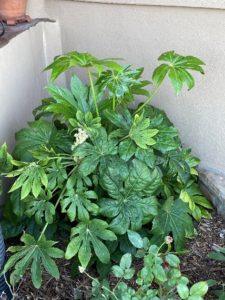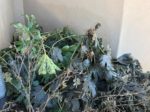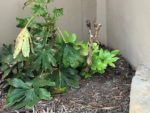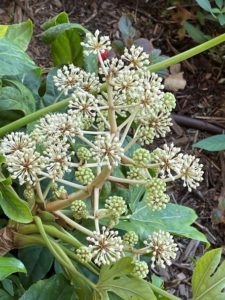Impulse Buy Becomes One Tough Plant

Fatsia Japonica – also known as Japanese Aralia
I have to admit it, I bought my Japanese Aralia (Fatsia japonica) off a discount shelf at a Houston big box store because I loved the shape of the leaves and it looked so healthy! It was the end of the summer season and they were clearing out their plants in favor of space for the upcoming Christmas trees – and my eyes always wonder toward any plant I’ve not seen before. The Aralia caught my eye, as the leaves were deep green and large, with 7 to 9 lobes per leaf, giving it a tropical appearance with its bold and shiny foliage. My purchase was a small 2-quart-sized plant with a single stem, but I soon learned that the natural growth is for multiple stems, with the overall plant remaining rounded in form.
Container Plant Worthy in Austin?
I started my plant in a container, as I read that it preferred some shade in the afternoon and my backyard is mostly sunny. I transplanted into a 14-inch container and it soon branched out and performed beautifully as a potted specimen. The next winter, I left it out during a short freeze, and realized that after I cut back the damaged leaves, the plant recovered and produced yet another summer of beautiful foliage for the patio.
I then moved from Houston to Austin the following winter and carried the plant with me. I noticed that in the Austin area many homeowners were using the Aralia as a landscape plant. That spring, I decided to move my Aralia from it’s container and plant it in a shady corner of my new backyard where I wanted interesting foliage and an anchor specimen with some height. My thought was to add seasonal color changes in the border area in front of the plant. It grew much quicker, achieving nearly 3 foot in height and width in it’s new home. Two years later, Winter Storm Uri tortured it with single digit temperatures for 6 days straight.
Aralias are Tough!

Fatsia Japonica after the historic February 2021 freeze
Positioned on the northside of my backyard, the Aralia was somewhat sheltered by the wind as it sits against a backwall. I didn’t even think to cover it, as it had always recovered from freezes before and didn’t realize what Uri was about to bring. Within days of the freeze, all the leaves soon turned ashen gray and dried up, like nearly everything else in the yard. I wasn’t sure if my little Aralia was going to survive the brutal winter this time.

Fatsia Japonica showing signs of recovery in April 2021
Then in March, I noticed a few leaves emerging from a new stalk. Taking the advice of Texas A&M Forest Service, I removed all the dead foliage, but left the dead-looking stalks in the ground. By April, I knew it had a chance to survive as more new leaves emerged and a second stalk appeared. By May, I felt comfortable removing the previous (dead) stalks, not seeing any growth emerging from them. It wasn’t long before the Aralia began to take its rounded shape and assuming it’s 3-ft height. In fact, the new growth was fuller and filling out the corner very nicely. And yet it surprised me again.
Aralias Bloom!

Fatsia Japonica sporting a fall floral display
I have had the Aralia over 5 years (in container and ground) and never saw a bloom. But this fall, starting in late October, a bloom began to appear from within the foliage. It soon opened to a beautiful flower, ending its bloom period with black seeds – just in time to feed the birds. And even with this winter’s short freeze periods, my Aralia remains green with only a few leaves showing minor damage. I’m betting I’ll see a larger plant than I’ve ever seen before this summer and look forward to yet another bloom period in the fall.
The Aralia is quite an anchor specimen deserving of any part-shade location. Even in the high alkaline soils of the St. Edwards Plateau, the plant enjoys consistent growth. Since the location of mine is very shady, it will likely not reach the reported 10ft height possible in sunnier locations. But even if it only reaches 5 ft., it’s a great showy plant for the landscape and the neighboring honeybees loved the flowers. In fact, it’s one of the few beauties in my landscape providing much needed pollinator food at the onset of winter. Which reminds me, with spring coming soon, it will be time to plant additional bulbs for fall flowering and the bulb catalogs are calling my name!
Additional Resources
Have a question about a specific plant or tree? Contact the Travis County Master Gardener Helpdesk at travismg@ag.tamu.edu.
Other Posts on this topic:
- Plant Freeze Recovery Tips
- Huisache – the 2021 Winter Storm Survivor
- Variegated Ginger – Surprising 2021 Winter Storm Survivor
Weather Strategies for Austin Gardens
Native and Adapted Landscape Plants searchable database
Climate Graph for Austin Bergstrom
About Yvonne Schneider

Yvonne was a 35+year veteran in the computer and information technology industry when she retired and moved from Houston to the Austin area. In 2018, Yvonne certified as a Travis County Texas Master Gardener to follow her passion for gardening and volunteering within the community. She has spent 20+ years enjoying gardening and working with bulbs and perennials. She now tackles the challenges presented by the Austin area wildlife, drought, and limestone soil.
